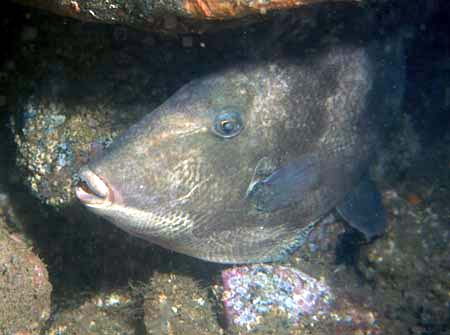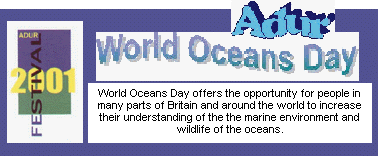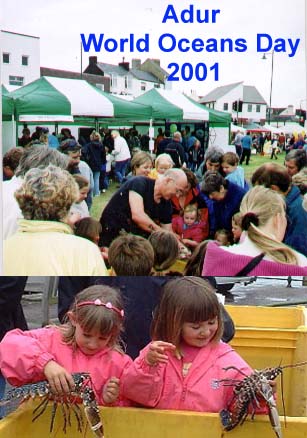
|
|
|
|
|
(BMLSS *** Site) |
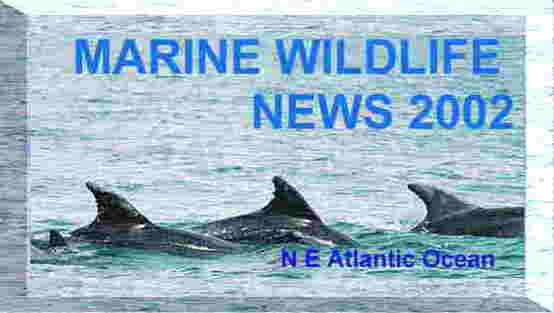
NEWS 2000 |
|
Norwegian Marine*** |
|
L-I-N-K-S to Other Sites (Click on Text) |
|
|
|
|
|
|
|
Recommended Sites |
|
|
|
|
|
|

Monthly Marine News Bulletin |
|
Marine Nature Conservation Review Survey Database |
|
|
 |
|
|
|
|
|
|
Index
|
|
Marine Wildlife News 2001
(British Isles)
with pollution incidents and conservation initiatives as they affect the fauna and flora of the NE Atlantic Ocean.
on Microsoft Internet Explorer (best) or Netscape
- 31
December 2001
A Common Sea Bream (=Couch's Sea Bream), Pagrus pagrus, was caught by angler Stephen Condick on the Quies off Newquay, Cornwall. It weighed in at 2.218 kg and is a new British record for this species. This southern species of fish has been reported on a few occasions this year and it is breeding off the Cornish coast (probably) and at least one specimen has been caught as far east as Hampshire. Hayling Island capture
British Angling Records
BMLSS Angling Records Page
December
2001
A
specimen of the cushion-like (short stubby arms) starfish Hippasteria
phrygiana was
trawled up from the north east coast of England and brought into St. Abbs,
Scotland. This is a northern Arctic species
and only rarely reported from the Shetlands and off north west Scotland.
there has been a report from St. Abb's before and this starfish is common
at diving depths off the Norwegian coast in the winter.
via the Marine Wildlife of the North-east Atlantic Ocean Group
31
December 2001
Thousands
of Common Starfish,
Asterias
rubens, were discovered washed up dead on the shore at Formby,
Merseyside, Lancashire.
BMLSS Echinodermata
26
December 2001
As
weather turns colder with nights below zero ° C, scores of dead Triggerfish,
Balistes
capriscus, have been washed up dead on the Cornish coast.
21
December 2001
A
Slipper
Lobster, Scyllarus
arctus, was caught in a lobster pot
at a depth of about 60 metres about three miles south east of St Mary’s,
Isles of Scilly , just before Christmas by Barry
Bennett. Realising that it was an unusual
and interesting find Barry put it in a display tank, which he maintains
in the Harbour Master’s Office in St Mary’s.
Scyllarus
arctus is a warm waters species found in the Mediterranean, and in
the Eastern Atlantic from Morocco to the English Channel but is rare north
of the Bay of Biscay. They live on stony ground, in caves, and can
also be found on muddy bottoms or in seagrass beds. They use the
large spade-like scales at the front of the head to burrow into mud, sand
or gravel between and under stones. Only 15 have been confirmed from British
seas all from off Cornwall, the Isles of Scilly or off Plymouth.
Full
Report
via the Marine Wildlife of the North-east Atlantic Ocean Group
5
December 2001
A
Green
Turtle, Chelonia
mydas, was washed up dead at Blackpool,
Lancashire. This is the first recorded Green
Turtle from Irish Sea coasts.
Post
Mortem Details
4 December
2001
The
carcass of a young 1.78 metre long female White-beaked
Dolphin, Lagenorhynchus
albirostris, was discovered on the small beach area west of Crovie,
in the outer Moray Firth, north-east Scotland. The young dolphin showed
signs of injury to its jaw consistent with being attacked. Although this
species of dolphin is regularly seen off Stonehaven and Aberdeen, it has
only been recorded once in the last five years in the outer Moray.
BMLSS Cetacean Page
1 December
2001
A
large 3.5 metre Pilot
Whale, Globicephala melas,
stranded on the Hannafore Beach at Looe, Cornwall, after first being discovered
floating in the sea the day before. This is just one of several reports
of dead whales seen around Cornwall during the month of November.
29
November 2001
A
Full Moon and spring tides, the second Full Moon
in the month is known as a Blue
Moon.
26
November 2001
A
very unusual report of a Barracuda
was received from Cornwall
where net fisherman David Kessell
captured one six miles off the Lizard peninsula. The streamlined tropical
fish has not been recorded in British seas before. This one weighed about
4.2 kg gutted (9 lb) and it was about 106 cm (nearly 4 ft) long.
This fish has been photographed by Phil Monckton
(Western Morning News)
and verified by Dr Paul Gainey.
Allthe three species in the family Sphyraenidae found in the North East
Atlantic and Mediterranean are southern species that are discovered only
north to the Atlantic coast of the Iberian Peninsula and southern Bay of
Biscay.
When
this specimen was examined at the Natural History Museum by Oliver
Crimmen it was found that the edge of the
operculum was naked (not covered in scales as it is in). This, along
with a few other features, showed the specimen to be Sphyraena
viridensis, known as the Yellowmouth
Barracuda. (Revision
June 2003)
Revised
Details
Full
Report
Full
Report (CD-ROM only)
via the Marine Wildlife of the North-east Atlantic Ocean Group
25
November 2001
A
seal
was seen off Brighton beach, Sussex in the English Channel. This is outside
the normal range of all species of pinnipeds.
It was swimming between Brighton's two piers heading east to west. The
seal swam at the surface and dived on occasions and appeared to be in good
health. They have been seen as occasional vagrants before, notably off
Shoreham
a few miles to the west.
Seal Conservation Society
Sussex Marine Life
24
November 2001
A
pod of 30 Harbour Porpoises,
Phocoena phocoena, were seen 20 miles
south of Salcombe, south Devon.
via the Devon & Dorset Wildlife Yahoo Group
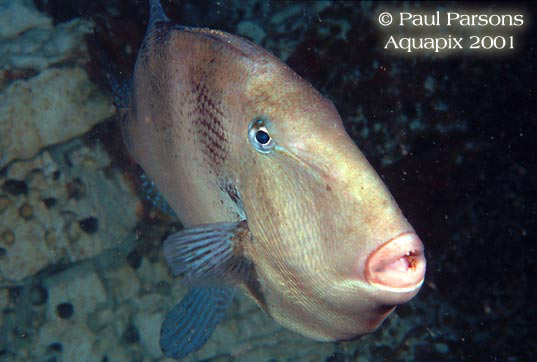 18
November 2001
18
November 2001
Triggerfish, Balistes capriscus, in fine condition were discovered inhabiting part of the undersea chalk cliff face known as the Worthing Lumps, about 3 miles off the Sussex coast. About 15 adult fish were found, most of them inhabiting the rock crannies in the clear cold (12° C) water, but one fish ventured out into the open. Divers rarely have the opportunity to observe Triggerfish in the winter because of the inclement weather restricts the diving opportunities.
Excellent photographs and Triggerfish information page (link)
17
November 2001
Two
specimens of the Straight-nosed Pipefish,
Nerophis
ophidion, were discovered on the south
Cornish shore of Hannafore Beach, Looe on the low
spring tides. These pipefish are resident large
(12 cm) pipefishes around the southern coast of Britain, and are probably
rarely recorded on a few shores rather than being a rare species of this
small elongated fish.
A Curled
Octopus, Eledone cirrhosa,
was discovered by Helen
Nott on Heacham Beach, Norfolk, In this
clear
photograph (click on this text to see), you can see the single row
of suckers. The Common Octopus has a double row.
BMLSS
Octopus page
15
November 2001
Stephen
Summers, found an intact Triggerfish,
Balistes
capriscus,
washed
up on Poltreath Beach in Cornwall.
Link
to the photograph and full report
15
November 2001
A Bottle-nosed
Whale, Hyperoodon ampullatus,was
discovered washed up dead on a beach in Skaill
Bay, (HY 229 189)
in the Orkney Isles. This whale is usually found in deep water.
BMLSS Cetacean Page
Report Numbers for Stranded Cetaceans
9 -14
November 2001
 A Leatherback
Turtle, Dermochelys coriacia, nearly
1.5 metres across was spotted close to the south Alloa jetty 30 miles up
the Firth of Forth, the major inlet on the east coast of central Scotland.
A search was conducted for the turtle to rescue it in case it became trapped.
However, in the vast expanse of the estuary the turtle could not be located
easily and it was
14 November 2001 before
it was discovered and photographed after an extensive and systematic search
in small boats.
A Leatherback
Turtle, Dermochelys coriacia, nearly
1.5 metres across was spotted close to the south Alloa jetty 30 miles up
the Firth of Forth, the major inlet on the east coast of central Scotland.
A search was conducted for the turtle to rescue it in case it became trapped.
However, in the vast expanse of the estuary the turtle could not be located
easily and it was
14 November 2001 before
it was discovered and photographed after an extensive and systematic search
in small boats.
CRRU Report
British Marine Turtle Stranding Network
5 November
2001
The
first Snowy Egret,
Egretta
thula, recorded in Britain is seen and photographed at Balvicar,
Argyll & Bute, and then in the following months seen over a wide area
of the west of Scotland. This bird normally inhabits the tidal mud flats
of North and South America where it hunts for small fish and shrimps
in large groups.
Reports
Photographs
BMLSS
Sea Birds
1 November
2001
There
have been further reports of Short-snouted
Seahorse, Hippocampus
hippocampus, from around the Channel Islands. Fisherman Steve
Ryall hauled them up in his nets together
with Lumpsuckers and large Soles over 3 kg in weight. The Seahorses
were returned alive. Lobster and crab fisherman Andy
Egre reports catching two large Seahorses
in his pots about a mile and a half off Rozel in 30 metres of water in
an area of strong tides.
31
October to 4 November 2001
The
beam trawler F.V. Admiral Gordon, fishing out of Plymouth, reports seeing
large numbers of Pilot
Whales, Globicephala
melas, for the first time about 12 miles South of Start Point, South
Devon. They estimate over 50 whales and report that they were also
picking up a lot of midwater markers (on the echo sounder) which may have
been herring.
via the Marine Mammals of the English Channel Smart Group
31
October 2001
Fisherman
Steve
Long caught a Common Octopus,
Octopus
vulgaris, off the Cornish coast off Coverack in deepish water at
about 75 metres (40 fathoms). This warm water octopus is now only rarely
discovered in the English Channel, although within just about living memory
it was commoner. This species was identified by Paul
Gainey, but hauling it up from the depths
damaged the specimen which did not survive its ordeal.
CephBase Octopus vulgaris
29
October 2001
A Pistol
Shrimp, Alpheus macrocheles, was
discovered by fisherman Timmy Bailey
in Falmouth Bay, Cornwall, and identified by marine biologist Paul
Gainey. This is one of a few small shrimps
that can produce a rather alarming cracking noise with their claws. It
was bright orange in colour. Exactly how rare they are in British seas
is unclear because they are small, up to 43 mm only, and are only rarely
reported. (There are two other species Alpheus glaber and Alpheus
ruber.) The Pistol Shrimp found a home at the Blue
Reef Aquarium in Newquay.
Information verified with Matt Slater at the Blue Reef Aquarium
25
October 2001
The
Grimsby
Evening Telegraph reported a 3 metre long (including the sword) Broad-billed
Swordfish, Xiphias gladius, discovered
by Ian and Graham Royle washed up dead on Chapel St. Leonards beach, Lincolnshire
on the east coast of England. This is usually an oceanic fish with just
a few reports in British seas, one or two sightings
in the English Channel of this fast swimming fish jumping out of the sea,
and one report of a fish washed on the west
coast of Scotland.
via the Marine Wildlife of the North-east Atlantic Ocean Group
23
October 2001
A
10 metres long Sperm
Whale, Physeter macrocephalus,
was washed up alive on the north-east side of Trondra (opposite Scalloway
Harbour) in the Shetland Isles. The whale managed to refloat itself the
following day, but as often happens with these strandings the whale beached
itself again in the original location.
21
October 2001
The
capture by angler Peter Godden
of a fish called the Blue Runner, Caranx
crysos, was an amazing occurrence of an Atlantic tropical (including
the Caribbean) and Mediterranean sea fish off Walmer Beach, Deal, Kent,
that speculation can only occur how did this fish arrive so far out of
its normal range? It weighed in at 175 grams and is very small and is a
new British record. Adults can attain a weight of nearly 4 kg.
Fishbase Entry
17
October 2001
A Bluefin
Tuna, Thunnus thynnus with a reported weight of 435 kg (960
lb)
is caught on road and line by Adrian Molloy
of Kilcar, off Donegal, Ireland. The angler
claims this as the largest fish caught around the British Isles, exceeding
the giant fish of 386 kg (851 lb) caught from a Whitby boat in 1933
when Tuna were a regular catch in the North Sea.
13
October 2001
A Wreckfish
was caught by angler Patrick Banks from
a mid channel wreck SSW of Poole Harbour, Dorset. This fish is a rare visitor
to the south western shores of the British Isles. It weighed in at 5.407
kg and is a new British angling record.

Wreckfish in the old MBA Public Aquarium at Plymouth (different fish)
10
October 2001
"Seahenge",
the important Bronze Age Timber Circle that was recovered from the seashore
at Holme, Norfolk, is to be saved and conserved for future generations.
The conservation programme, fully funded by English Heritage, will take
place at the Flag Fen archaeological centre
near Peterborough. The "Seahenge" timbers have been precisely dated to
spring 2050 BC and 2049 BC using pioneering dating techniques.
8 October
2001
A Pandora
Bream, Pagellus erythrinus, was
caught by angler Phillip Jewell
in the River Helford
estuary, Cornwall. This is one of the rarer summer visitor sea breams
(Family: Sparidae) to the English Channel. This was a new British angling
record and the fish weighed in at 692 grams.
28
September 2001
A
14 metre long female Sei Whale, Balaenoptera
borealis, was washed up alive at Cockerham Sands, Lancashire
on 28 September
but quickly died. It was then washed out to sea again and it then drifted
northwards across the Morecambe Bay to Chapel Island, Ulverston. The decomposing
carcass drifted to Greenodd Sands where it was photographed by Andy
Harmer on 13 October 2001.
The Sei is a deep sea whale and records of strandings are rare.

BMLSS Cetacean Page
Previous Sighting
27
September 2001
A
commercial fisherman, Rick Ferbrache,
caught a 63 mm (2.5 inch) long brown
Short-snouted Seahorse, Hippocampus
hippocampus, in a parlour crab pot while fishing 1.5 miles north
west of Pembroke off Guernsey's north coast.
After five years of extensive summer survey work for marine mammals in the Moray Firth off the east coast of Scotland, we discovered a pod of seven Risso's Dolphins, Grampus griseus, including a mother and calf, in the outer southern Moray Firth. This species is not attracted, to boats but it is also not one of the five commonest dolphins seen around the British Isles. It is rather a rare discovery in British seas.
Cetacean List (NE Atlantic)
24
September, 2001
100+ Common
Dolphins, Delphinus delphis,
seen chasing a shoal of Mackerel one mile off
St. Martin's Point, Guernsey, during the evening. Calves were present and
sounds were heard. Observers even managed to touch one or two of the dolphins.
Some estimates said there were 30 pods of about 10 dolphins in each pod,
so could be as many as 300.
BMLSS Cetaceans
15
September 2001
Five Columbus
Crabs, Planes minutus are
washed ashore on the Belgian coast. These
crabs are rarely recorded pelagic life with British records only from the
extreme west coasts, with the only Cornish records of the crab coming from
the 19th century.
Planes
minutus is also called the Gulf-weed
Crab because the largest population of this
abundant crab is believed to inhabit the open Atlantic Ocean area known
as the Sargasso Sea.
These crabs are also found on the east coast of America. This crab is also
known as an epibiont
of the Loggerhead Turtle, Caretta caretta.
BMLSS Crustacea Page
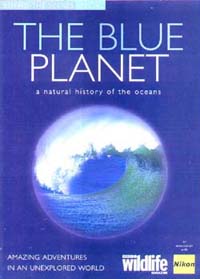 12
September 2001
12
September 2001
BLUE
PLANET
A
new series on BBC ONE
from
Wednesday, September 12 at 9.00 pm
Narrated
by David Attenborough
From
the BBC Natural History Unit, The Blue Planet is the definitive exploration
of the Earth's final frontier - from the deep to the shore, from pole to
pole. The eight 50 minute programmes will transport you around the globe
revealing extraordinary life and behaviour that has never before been filmed.
In some cases these have only recently been known to scientists.
Programme
1 - Introduction
"Our
planet is a blue planet," says David Attenborough.
"Over
70 per cent of it is covered by the sea and the Pacific Ocean alone covers
half the globe." The oceans dominate the world's weather systems, and support
an enormous variety of life, from the largest animal that has ever lived
on Earth, the blue whale, to the tiniest plankton."
BBC
Blue Planet Page
Television
Programmes in the series (BBC)
c.
20 September 2001
There
have been several reports of unusual Sea Breams (family: Sparidae)
from around the Channel Islands. Shore angler Kevin
Frain caught a Gilthead
Bream, Sparus aurata, and there
was a report of a White Sea
Bream, Diplodus sargus, from St.
Helier Marina, Jersey. Neither of these catches have been verified by an
expert or confirmed by a photograph but they are likely to be accurate.
14
September 2001
A
large (38 kg) and beautiful fish called the Opah,
Lampris
guttatus, was landed by a commercial fisherman (MFV Seagull out of
Srabster) trawling for cod and ling at a depth of 250 metres west of the
Shetland Isles. This is an epipelagic fish, which it inhabits the surface
waters off the Continental Shelf. This means that accidental catches and
strandings of this fish are rare by British fishermen or washed up on remote
shores. There has even been records of this fish caught by anglers up to
58 kg. This fish has been recorded to depths of 400 metres.
4
September 2001

- A
four metres long Northern Bottle-nosed
Whale, Hyperoodon ampullatus, was discovered washed dead by
a a local fish farm employee on the shore near Secastle Bay on the Isle
of Mull side of the Sound of Mull off the west coast of Scotland. The post-mortem
revealed that the stomach was full of squid beaks.
BMLSS Cetacean Page
Cetacean List (NE Atlantic)
Monitoring Marine Mammals in the Atlantic Margin
Summer
2001
A
remarkable explosion of the nudibranch (sea slug) Geitodoris
planata has occurred in the Oosterschelde Bay, in the southwest
of the Netherlands. The first specimen recorded from the Netherlands was
found in June 1999. By July 2001 it is not unusual to find more than 30
adult specimen and over 70 egg ribbons on a single dive. Furthermore they
are all of a extraordinary size of up to 12 cm. in length. Bernard
Picton reports 65 mm. as a maximum size!.
They are only found in this single bay and nowhere else at the Dutch coast.
This species will not be listed in popular books and is not even to be
found in specialised synopses.
Geitodoris
planata is often confused with the Sea
Lemon, Archidoris pseudoargus.
BMLSS Sea Slugs
31
August 2001
One
Humpback
Whale, Megaptera novaeangliae,
is seen from the Fair Isle (the small island between the Orkneys and the
Shetland Isles), blowing and fluking, with 12 White-beaked
Dolphins, Lagenorhynchus albirostris.
Humpback Whales
are reported in the seas just south of the Shetlands every summer.
BMLSS Cetacean Page including a Humpback in Cornwall
Humpback Whales (Shetland Isles) 2000
28
August 2001
William
Cooper of the Kaspia restaurant in London's Mayfair received
a European Lobster, Homarus gammarus,
96 cm long in the normal delivery from Cornwall. Because of its exceptional
size it was presented to London
Aquarium. This is one of the largest lobsters ever caught. We have
one record of a specimen 126 cm long, but even the very large ones that
are occasionally caught are usually less than 1 metre in length. It weighed
over 6 kg (about 14 lb).
On
18
October 2001, this Lobster called "Barney"
was released into the Plymouth Sound Marine Conservation Area.
Specimen
Lobsters
19
August 2001
A Triggerfish,
Balistes
capriscus, was discovered in
the sea to the north of the island Muck (Sound of Eigg) off the west coast
of Scotland (north of Ardnamurchan, south of Rum, south of Skye). This
fish was reported by skipper
Andy Tibbets,
seen
by a diver on
Godag
Reef at a depth of 20 metres. This was the first one he has ever caught
this far north, although another one was reported from the same area a
few years ago.
30
July 2001
A Ringed
Seal, Phoca hispida, was discovered at Cullivoe (Yell) in the
Shetland Isles. It is only the second record for Shetland of this Arctic
species. The only other definite record was one shot on Whalsay in 1968
(Berry & Johnston 1980). This species looks similar to the Common Seal,
Phoca
vitulina, and has probably been overlooked before, although they are
still rare in British seas. Their main distribution areas are the
Arctic coasts of Europe, the USSR, Canada and Alaska, including Nova Zemlya,
Spitsbergen, Greenland and Baffin Island. The Baltic population is the
subspecies Phoca hispida botnica.
including a photograph.
Shetlands Seal Page
Ringed Seals Information
Shetland Wildlife Records 2001
29
July 2001
A
Hooded Seal, Cystophora cristata, was washed on a Little Haven
beach, Pembrokeshire, south west Wales and found a home at the Seal Hospital
at Milford Haven. The seal was healthy apart from a small cut on one flipper.
The Hooded Seal spends most of its life on the Arctic pack ice and discoveries
off the coast of Scotland, including the Orkney and Shetland Isles are
rare. It moults around Greenland and the Denmark Strait (between Iceland
and Greenland) with regular sightings now being reported from the seas
north of the Shetland Isles.
Hooded Seal Information
Seal Conservation Society
Seals Page
Monitoring Marine Mammals in the Atlantic Margin
29
July 2001
There
were a considerable number of Compass Jellyfish, Chrysaora
hysoscella, off
Hallsands Beach, south Devon. I counted well over a hundred. There was
also a small (25 cm across) Cyanea which was bright blue, it could
have been Cyanea lamarcki due
to its size, colour and lack of sting (I brushed past it whilst swimming).
Original Marine Wildlife of the North-east Atlantic Ocean Group Report (Link)
Compass Jellyfish were reported by Paul Tyler from around St. Kilda (Outer Hebrides) this year.
Paul Tyler Reports from St. Kilda, of String Jelly, Salps, Cotton-spinner (sea cucumber) Holothuria forskali, and the starfish Stichastrella rosea.
23
July 2001
Unidentified
Shark
Two
divers, one of them a commercial fisherman, came across an unrecognised
shark lying stationary on the bottom near Alderney in the Channel Islands.
It was over a metre long and it was not any of the common shark species
normally found around the islands. They looked in the book and came up
with unlikely match of the Nurse Shark,
Ginglymostoma
cirratum. They said the shark remained
motionless on the bottom. The body appeared dark grey with no markings.
This
tropical species has never been recorded in British seas although Gerald
Jennings (Calypso Publications) reports a record from Portugal.
Full Report
 24
July 2001
24
July 2001
In
the evening whilst on a routine Minke Whale survey along the southern Moray
Firth, biologists from the Cetacean Research
& Rescue Unit had a truly amazing experience when they encountered
an 11.5 metre long adult Humpback
Whale, Megaptera novaeangliae,
just three miles from the coastline of the outer firth.
Humpbacks
are rare visitors to British waters. There has only been on rare stranding
report this year. Humpbacks are a deep water whale.
The
Humpback Whale was seen again by the research team in relatively shallow
water on 11 August 2001.
Orkney Isles Report 2001
BMLSS Cetacean Page including a Humpback in Cornwall
Humpback Whales (Shetland Isles) 2000
23
July 2001
Beaches
along a twelve-mile stretch of rocky Welsh coastline near Holyhead on the
island of Anglesey in North Wales were covered with "dumpling like" globules
of the white and brown gunk, identified as non-toxic vegetable oil.
Full
Story
19
July 2001
Numerous
Sunfish,
Mola
mola, (pic) were seen off the coast of Cornwall
as is usual during the summer months. One was discovered in the Hayle river
estuary near St. Ives where it was reported breaching in a large rock
pool. On
13 July 2001, nine
Sunfish were seen off Pentire Head, Cornwall (SW 936814) between Rumps
and Mouls.
18
July 2001
A
large (15 kg) Stingray,
Dasyatis
pastinaca, caught off Helford, Cornwall
was landed at Newlyn. A small (15 cm) Marbled
Electric Ray, Torpedo
marmorata, was caught in a crab
pot off Freathy, Whitsand Bay, south-east Cornwall. Both fish are quite
rare for the south-west.
Portuguese
Man-o'War, Physalia
physalis,
were
sufficiently numerous off Bordeaux, north-east coast of Guernsey, Channel
Islands for the Police to publish a warning to bathers.
15
July 2001
An
Oceanic Pufferfish,
Lagocephalus
lagocephalus, was discovered washed up on the surfline by a holidaymaker
on Towan beach, near Newquay, on the north coast of Cornwall. At first
the fish that was over 30 cm long seemed to be dead, but it recovered after
being placed in a rockpool, and was eventually
taken in a plastic shopping bag to the Blue
Reef Aquarium at Newquay where it quickly recovered, and began swimming
around with rays and other fish in a large display tank.
This
was a very unusual discovery in British seas. The last confirmed discovery
was in 1973, but there have been a few unconfirmed reports since then.
It is a worldwide pelagic species in all the warmer oceans, and inhabiting
the open Atlantic and rarely comes inshore.
The
Pufferfish is named from its ability to inflate into a large ball when
threatened.
A young (1.5 metre long) Thresher Shark found at Gunwalloe Fish Cove, on the Lizard, Cornwall has been confirmed as a Bigeye Thresher Shark, Alopias superciliosus. This is the first record of this species from shallow British waters.
6 July
2001
Sixty
Bottle-nosed
Dolphins, Tursiops truncatus, were observed by
Craig King from a fishing boat three miles
south of Portland Bill, Dorset at around 10.00 am. The large group
included calves and may have been chasing mackerel.
Several animals came in to ride the bow wave. A Thresher Shark,
Alopias
vulpinus, was also seen rounding up smaller fish ten miles offshore
of Portland.

26
June 2001
Hundreds
of jellyfish were seen off Sandgate, Kent. They
were about 12 cm in diameter but have not yet been positively identified.
This could be the uncommon species Cyanea lamarckii.
24
June 2001
The
London TV news reported the presence of an adult Bottle-nosed
Dolphin, Tursiops truncatus, in the Thames near the Tate Modern
Gallery. From the film footage the dolphin appears reasonably 'fit' at
the moment and quite active. It was over 3 metres (11 ft) long.
 June
2001
June
2001
OCEAN Guides
Whales &
Dolphins of the European Atlantic
The
Bay of Biscay and the English Channel
by
Graeme Cresswell & Dylan Walker
and
Rob Still & Phil Coles (artwork)
and
individual photographers
Edited
by Andy Swash
Published
by Wild Guides
ISBN
1-903657-00-8
This is the best and handiest small guide, and probably better than any of the larger guides for identifying the cetaceans at sea. Andy Horton
ORCA
Organisation Cetacea
UKCetnet
Whale
& Dolphin Conservation Society
BMLSS
New Publications Page
BMLSS
Cetaceans
Marine
Mammals of the English Channel Smart Group
21
June 2001
Seaquest
recorder Barry Moreton has reported a record number of the Ocean
Sunfish, Mola mola, off Pentire Headland (east side of the
Camel Estuary), Cornwall. Within about 8 hours, whilst he was fishing from
land, he counted 48 in groups of two or three, Douglas
Herdson of the National Marine
Aquarium, who is compiling records of this species for the whole of
the British isles, says that 15 is the largest grouping of which
he knows.
Coincidentally Terry Hocking who has been keeping careful notes of seal activity off the North Cliffs, has just given his notes to Cornwall Wildlife Trust together with observations on Sunfish. He has noticed that gulls - seemingly always immature Herring Gulls - frequently gather around them. If the gulls attentions are too insistent, the Sunfish will lunge at them, squirting water from its mouth! - and he has a video to prove it. I can find no mention of this in the literature or on the World Wide Web (Internet) - indeed in general there seem to be more questions than answers at present, although it seems certain that the Ocean Sunfish is becoming more frequent and extending its range in British waters..
Sunfish
(BMLSS)
Seaquest
SW (Cornwall Wildlife Trust web pages)
National
Marine Aquarium, Plymouth
18
June 2001
A
small shoal of juvenile first year Pollack,
Pollachius
pollachius, came as a great surprise to me on a mussel
collecting
expedition at Kingston beach,
Shoreham-by-Sea,
West Sussex (Adur
estuary)
In well over a thousand observations I have never seen shoals of these
fry before. The mid-water shoals are usually Sand Smelt Atherina presbyter;
Bass,
Dicentrarchus
labrax; or Grey Mullet,
Chelon labrosus. Pollack shoals are
are a characteristic of Cornish and Devon estuaries.
17
June 2001
An
angler caught a Common Sea Bream, Pagrus
pagrus (=Sparus), out of Hayling Island. It is only called common
because it is common in the Mediterranean Sea and south of the British
Isles.
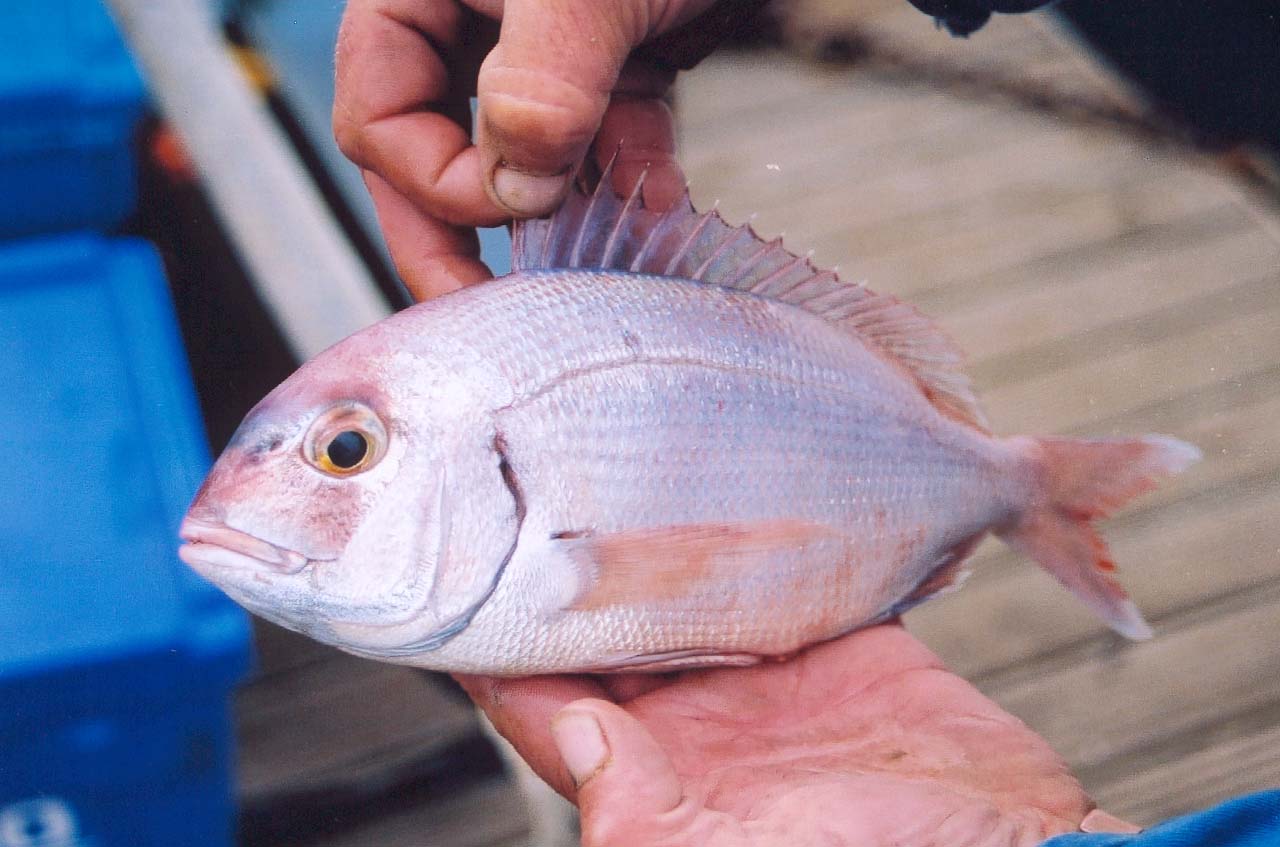
It was previously rare in the English Channel and unknown any further north. However, in the last two years a shoal of juveniles have been discovered in a Cornish bay and large numbers have been caught around the Channel Islands. This is the first record received of a fish as far east as off Hampshire.
 8,
9, 10 June 2001
8,
9, 10 June 2001
World
Oceans Day events at Plymouth, Helston,
Swansea,
Moray
Firth,
Flamborough
Head etc.
8 June
2001
World
Oceans Day
6 June
2001
Three
large baleen Whales were spotted for about 30 minutes blowing
well offshore from Cork, Ireland and swimming west along the coast. These
were possibly the same Fin Whales the Air-Corp observed two days
earlier.
BMLSS
Cetacean Page
5 June
- 28 July 2001
Three Killer
Whales, Orcinus orca, were observed around the mouth of Cork
Harbour, Ireland. The group comprises one very impressive bull with an
equally impressive dorsal fin and two smaller adults, presumably females,
although some observers have mentioned a fourth animal.
Full
Reports on Marine Wildlife of the North-east Atlantic Ocean Group
See
UK CetNet for even more reports
2
June 2001
A
mantis
shrimp, Rissoides desmaresti, has been found in Lyme Bay.
The specimen was captured by a local fishermen in a trawl net. The specimen
was around 85 mm and was captured with a good haul of cod which were feeding
upon the mantis shrimps.
|
2 June 2001 A pair of Mute Swans with six furry cygnets greeted the workers setting up at the stalls for Adur World Oceans Day, but as the neap tide ebbed they had disappeared before the start of the event.
The
day was overcast with brief periods of sun through gaps in the clouds and
short periods of torrential rain that sent people diving for cover in the
marquee.
|
27
May 2001
Despite
the rough weather, a Sunfish was spotted
by anglers on a boat about half an hour out from Lyme Regis, Dorset, and
reported by Tom Parker.
24
May 2001
Large
plankton blooms are prominent on both sides of the English Channel and
at least as far west as Dorset.
Phaeocystis
Phaeocystis
is a minute organism which can reproduce in enormous numbers, and is an
example of the phytoplankton. Phaeocystis 'blooms' are called by
names like Slurry Water and Baccy Juice, and are an annual occurrence off
the Sussex and Kent coasts in May and June. Blooms are also found of other
coasts including the coast of Cornwall. The Sussex species is Phaeocystis
pouchetti.
Marine
Wildlife of the North-east Atlantic Ocean Group
Off Ramsgate, Kent, the blooms of phytoplankton were followed by large swarms of colourful jellyfish. Report by Keith Parsons
20
May 2001
Benty
and a group of seven Bottle-nosed Dolphins,
Tursiops
truncatus, including a calf, and swam
with canoeists for a whole day in 10 metres of water, chasing sand-eels
opposite South Sands and out to Bolt Tail, Salcombe, south Devon.
17
May 2001
Fishermen
Peter
Gay and Peter Drelaud caught a red
Lobster,
Homarus
gammarus, off the south east of Jersey, in April. Fisherman Ian Stewart
who caught one in 1971 (this may have come from the English Channel N.J.)
said that he understood the last locally recorded case was 1920. The Lobster
was sold to an aquarium at St. Malo, France.
15
May 2001
Basking
Sharks have been seen in appreciable numbers off the south Devon
coast. Ten sharks were seen feeding just outside the mouth of the Salcombe-Kingsbridge
estuary.
6
May 2001
A
pod of six Risso's Dolphins,
Grampus
griseus, (5 adults, 1 juv) were seen by Jonathan
Wills in Vassa Voe, South Nesting, in the
Shetland Isles, swimming very slowly around the inner part of the voe,
mostly in water less than 5 metres deep, keeping close together and possibly
supporting/nursing/comforting one of the party which appeared to have an
injured dorsal fin.
20
April 2001
Jon
Tonkin from Cadgwith on the Lizard peninsula caught a Sturgeon,
Acipenser
sturio,
whilst netting for Monkfish and Turbot. It was 2 metres long and
weighed 46 kg (101 lb). It was eventually served up in a Bath
restaurant. Records of Sturgeon are very rare and the fish must be heading
for extinction in the NE Atlantic as there are very few breeding areas
left.
April
2001
A
scallop fisherman (dredger) picked up 3 Pen Shells or Fan Mussels
in his dredge worked of the Channel Islands. One of them is at the
Guernsey
Aquarium. I had a look yesterday through the glass and I think
it is Atrina fragilis.
4
April 2001
Thousands
of tonnes of the 65 metres high chalk cliff at Beachy Head, East
Sussex, collapsed into the sea, including the complete stack known as Devil's
Chimney. After the persistent rain with hardly a dry day since
September 2000 a collapse was likely, and if the water inside the chalk
had frozen and expanded, a much greater fall could have occurred.
2 April
2001
A
Swanage lobster fisherman has just caught his second Seahorse, Hippocampus
guttulatus (=H. ramulosus), this week - the first was smooth,
the second very fluffy! Seahorses have been reported from Weymouth Bay
and the Fleet in Dorset and there are anecdotal reports of seahorses from
Studland eelgrass beds, but about 20 years ago.
via Marine Wildlife of the North-east Atlantic Ocean Group
1
March 2001
After
a long delay the
year 2000 Millennium issue of Glaucus
is finally sent to British Marine Life Study Society members.
20
March 2001
A
male juvenile Humpback Whale, Megaptera
novaeangliae, became stranded in Sandwich Bay, just north of Dover,
Kent. The animal was alive when it stranded, and estimated to weigh over
20 tonnes with a length of 11 metres (35 ft). Unfortunately, the animal
was in poor condition and could not be saved. The southern North Sea is
a very unusual area to find such a large whale.
More Information on UK Cetnet
BMLSS Cetacean Page
Report Numbers for Stranded Cetaceans
The
Glaucus
2000 CD-ROM is sent to
British
Marine Life Study Society Premier members
13
March 2001
A
young Loggerhead Turtle, Caretta caretta, was discovered
at Holywell Bay near Newquay, Cornwall, and is now being cared for at the
Blue
Reef Aquarium in Newquay.
27
February 2001
A
group of 3 or 4 Humpback
Whales, Megaptera novaeangliae, were seen in Echna
Bay, Burray, Scapa
Flow, Orkney.
18
February 2001
A
Basking
Shark, Cetorhinus maximus, was seen at the Roches Douvres,
near Jersey in the Channel Islands. It was over 6 metres (20 ft) long.
In summer they would not warrant a special report, but English Channel
sightings in winter are uncommon.
February
2001
Every
year scores of dolphins are washed up dead on the shores of Cornwall and
Devon.
Jon
Makeham (Looe) has sent a report to the Marine
Wildlife of the North-east Atlantic Ocean Group from information in
the Cornish Times.
Dolphin
Report
14
February 2001
A
huge Bass, Dicentrarchus
labrax, was caught in a trawl west of Guernsey. Its weight of 9.52
kg (21 lb 4 oz) would have exceeded the world angling record
if it had been caught on rod and line.
Angling Records
For
the first time for many years a good haul of the Brown
Shimp, Crangon crangon, was reported from the shallow seas
off Shoreham-by-Sea, Sussex.
Gallons of shrimps were collected in a push net at low tide. No Weevers
were netted.
12
February 2001
A
male Sperm Whale, Physeter
macrocephalus, was washed ashore in a badly decomposed state at Vault
Beach, Gorran Haven, St Austell, Cornwall. It was about 12 metres
long. It is only the third on record washed up on the Cornish coast.
12
February 2001
Two
badly decomposed Dolphins were washed up on Shoreham
Beach, Sussex. They were badly decomposed but were probably Common
Dolphins, Delphinus delphis. A Porpoise, just over a
metre long, was washed at nearby Worthing.
Sussex
Dolphins
Sussex
Cetaceans 2001
Sussex
Sea Watch Foundation News 2001
9 February
2001
A
Bogue, Boops boops, a fish weighing 491 grams was caught in
a gill net off Herm Island near Guernsey. These fish, a member of the Sea
bream family Sparidae, are reasonably common around the Channel Islands,
but are much rarer further north.
6
February 2001
A Dolphin
calf is reported from Durlston Bay, Dorset.
Durlston
Marine Project has records of Bottle-nosed Dolphin, Tursiops
truncatus, sightings around Swanage based on regular watches over the
past seven or more years. There appears to be more reports in the winter,
with little activity over the summer months. There have been regular
sightings of five recognisable dolphins over this period, with a couple
of newcomers in recent years.
I
photographed a group of 14 dolphins off Swanage in mid-January - including
a very young calf. One of the group was "Benty" - a very recognisable
individual with a bent-over dorsal fin, known from Cornwall and known to
have visited Dorset the previous year.
Young
dolphins are almost unknown from the English Channel.
3
February 2001
The
sea anemone Diadumene
cincta has been identified and photographed by Paul
Parsons off Worthing, West Sussex at a depth of 3 metres. It is a small
sea anemone that has probably overlooked before or incorrectly identified.
31
January 2001
Small
Couch's
Sea Bream, Pagrus pagrus, have been
numerous around Guernsey so far this year. The Guernsey Fishermen's Trading
Company says they have seen dozens. . One fisherman operating a small
trawler / potter landed to a retailer 16 all weighing about 340 grams (12
oz)
each. The neighbouring retailer in the Town Market had 6 small Couch's
Sea Bream delivered.
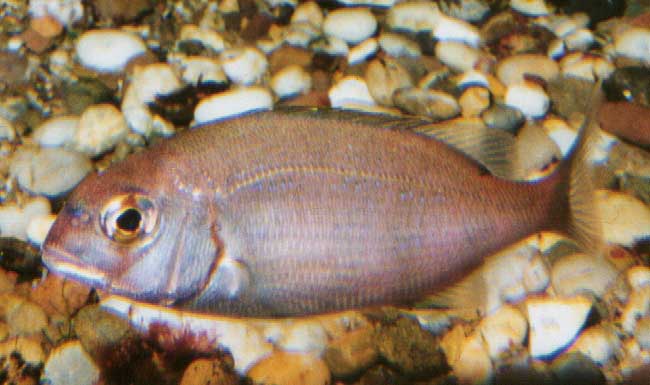
Couch's Sea Bream, also called the Common Sea Bream, reach their most northerly point of distribution in the English Channel and are not regularly recorded, although year 2000 was graced with quite a number of reports of sea bream from more southerly seas.
28
January 2001
Jean
Lawman and others spotted a large 8-10 metre
long Minke Whale,
Balaenoptera
acutorostrata, off Porthcurno, Cornwall. This specimen was larger than
one seen earlier in January.
Luke
Richards discovered a blue specimen of the Common
Hermit Crab, Pagurus bernhardus from the east coast of the
Isle of Wight. The legs and body of this hermit crab are usually orange
and cream. A parasitic rhizocephalan
barnacle could be responsible for this phenomenon and the exact species
is still a subject of discussion on the "Wet
Thumb" Smart Group. There does not seem to be a reason why this is
so, other than a blue Spider Crab,
Maja
squinado, was discovered to be parasiticised. However, list members
of the Crustacean-L grouphave
also suggested genetic, diet and environmental reasons for the colour abnormality.
The
blue Hermit Crab moulted on 9 February 2001,
and as the rhizocephalan parasite prevents moulting, it seems unlikely
this is the cause of the colour change. A Spiny Spider Crab in another
Isle of Wight aquarium also moulted to a blue colour.
Discussion
Link (Wet Thumb)
European
Rhizocephalan Species List
Discussion
(Marine Life of the NE Atlantic Smart Group)
Discussion
(Crustacean-L group)
22
January 2001
Andy
Horton attended the Marine Life Biological
Recording Workshop organised by the Marine
Biological Association of the UK & Marlin
on behalf of the British Marine Life Study Society
12
January 2001
Jim
Hall discovered the curious lamellarid mollusc called Lamellaria
perspicua on a bare boulder on the extreme lower shore (on a spring
tide) of Lydstep beach, 3 miles from Tenby, SW Wales.
This
prosobranch mollusc has also been discovered
by Jon Makeham
at Hannafore Beach, Looe, Cornwall.
January
2001
A
large Common Octopus, Octopus vulgaris,
was caught by a Cornish trawlerman Alan Nudd and housed at Newquay
"Blue Reef" Aquarium. It was a large specimen with a span including
the arms of 150 cm (5 ft). Common Octopuses are common in the Mediterranean
but unusual in the English Channel., with only a handful reported each
year. However, the smaller Curled Octopus, Eledone cirrhosa, with
only a single row of suckers, is found off most British coasts.
7 January 2001
Several hundred Long-spined Bullheads, Taurulus bubalis, were found washed up on the strandline on Lancing beach, West Sussex. This has not been recorded before. It was breeding time for these small fish.
Report by Robert Clark, Sussex Sea Fisheries Committee7 January 2001
A pod of 20-25 Bottle-nosed Dolphins, Tursiops truncatus, were reported to us off Noirmont (SW Jersey). Bottle-nosed Dolphins are seen regularly around Jersey in the first 2 months of the year.Report by Nicolas Jouault
1 January 2001
An oiled Gannet is reported from Widewater Lagoon, Lancing, Sussex. This was the first sign of a small oil spill off the Sussex coast with scores of oiled Guillemots and other birds.
Sussex RSPCA, Tel: 0300 1234 999.Report by Ray Hamblett
The Marine Wildlife of the NE Atlantic Forum commences.
PLEASE JOIN

MARINE WILDLIFE of the NE ATLANTIC EFORUM PAGE (LINK TO)
Shetland Wildlife
News & Information on the Wildlife of Shetland http://www.wildlife.shetland.co.uk/Cornish Wildlife
Vince Smith's Cornish Mailing List
Send a message to the list at: CornishWildlife@onelist.com
News 2000
News 1999
|
Use these links if your are familiar with the scientific classifications of marine life |
The BMLSS (England) site commenced on 1 January 1997.
|
|
 |
 |
Andy Horton, Webmaster
|
|
|
|
|
|
Membership Form |
News 2000 |
